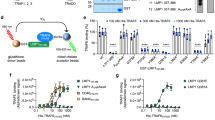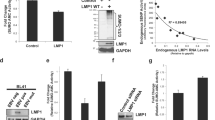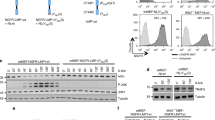Abstract
The latent membrane protein-1 (LMP1) is an integral membrane molecule expressed by Epstein–Barr virus (EBV) during viral latency and displays properties of a constitutively activated member of the TNF receptor family. LMP1 is required for B-cell or monocyte immortalization induced by EBV and is sufficient to transform rodent fibroblasts. Transforming potential of LMP1 is mediated by its cytoplasmic C-terminal domain, which activates various cellular signaling pathways including NFκB and JNK. In this report, we constructed mutants of LMP1 with preserved membrane spanning domain but mutated in the C-terminal domain and a second truncated C-terminal LMP1 fused to the enhanced green fluorescent protein. This latter mutant, termed LMP1-CT, impairs signaling by ectopic LMP1 as well as endogenous EBV-expressed wild-type (wt) LMP1. In contrast to dominant-negative mutants of LMP1 with preserved membrane spanning domains, LMP1-CT was unable to bind wt LMP1 to form an inactive complex. Its dominant-negative effects were due to binding and sequestration of LMP1 adapters TRAF2 and TRADD as assessed by coimmunoprecipitation experiments and confocal analysis. The effect was selective since LMP1-CT did not inhibit IL-1β-induced signaling, whereas it impaired TNF-triggered NFκB and JNK signals without affecting TNF-induced apoptosis. In addition and in contrast to LMP1 constructs with membrane localization, LMP-CT did not display cytostatic properties in noninfected cells. Importantly, LMP1-CT inhibited survival induced by LMP1 in an EBV-transformed T-cell line expressing the type II viral latency commonly found in the majority of EBV-associated human tumors. These data demonstrate that LMP1-CT is a new tool to explore the differences between LMP1 and TNF signaling and may facilitate the design of molecules with potential therapeutic roles.
This is a preview of subscription content, access via your institution
Access options
Subscribe to this journal
Receive 50 print issues and online access
$259.00 per year
only $5.18 per issue
Buy this article
- Purchase on Springer Link
- Instant access to full article PDF
Prices may be subject to local taxes which are calculated during checkout










Similar content being viewed by others
References
Aggarwal BB . (2003). Nat. Rev. Immunol., 3, 745–756.
Baud V, Liu ZG, Bennett B, Suzuki N, Xia Y and Karin M . (1999). Genes Dev., 13, 1297–1308.
Brennan P, Floettmann JE, Mehl A, Jones M and Rowe M . (2001). J. Biol. Chem., 276, 1195–1203.
Brodeur SR, Cheng G, Baltimore D and Thorley-Lawson DA . (1997). J. Biol. Chem., 272, 19777–19784.
Cheng G and Baltimore D . (1996). Genes Dev., 10, 963–973.
Coffin WF, Geiger TR and Martin JM . (2003). J. Virol., 77, 3749–3758.
Devergne O, Hatzivassiliou E, Izumi KM, Kaye KM, Kleijnen MF, Kieff E and Mosialos G . (1996). Mol. Cell. Biol., 16, 7098–7108.
Devergne O, McFarland EC, Mosialos G, Izumi KM, Ware CF and Kieff E . (1998). J. Virol., 72, 7900–7908.
Eliopoulos AG and Young LS . (1998). Oncogene, 16, 1731–1742.
Eliopoulos AG and Young LS . (1999). Semin. Cancer Biol., 11, 435–444.
Eliopoulos AG, Gallagher NJ, Blake SM, Dawson CW and Young LS . (2001). J. Biol. Chem., 274, 16085–16096.
Floettmann JE and Rowe M . (1997). Oncogene, 15, 1851–1858.
Gires O, Kohlhuber F, Kilger E, Baumann M, Kieser A, Kaiser C, Zeidler R, Scheffer B, Ueffing M and Hammerschmidt W . (1999). EMBO J., 18, 3064–3073.
Gregory CD, Murray RJ, Edwards CF and Rickinson AB . (1988). J. Exp. Med., 167, 1811–1824.
Groux H, Cottrez F, Montpellier C, Quatannens B, Coll J, Stehelin D and Auriault C . (1997). Blood, 89, 4521–4530.
Henderson S, Rowe M, Gregory C, Croom-Carter D, Wang F, Longnecker R, Kieff E and Rickinson A . (1991). Cell, 65, 1107–1115.
Higuchi M, Kieff E and Izumi KM . (2002). J. Virol., 76, 455–459.
Horie R, Watanabe T, Ito K, Morishita Y, Watanabe M, Ishida T, Higashihara M, Kadin ME and Watanabe T . (2002a). Am. J. Pathol., 160, 1647–1654.
Horie R, Watanabe T, Morishita Y, Ito K, Ishida T, Kanegae Y, Saito I, Higashihara M, Mori S, Kadin ME and Watanabe T . (2002b). Oncogene, 21, 2493–2503.
Hsu H, Shu HB, Pan MG and Goeddel DV . (1996). Cell, 84, 299–308.
Hueber AO . (2003). Cell Death Differ., 10, 7–9.
Izumi KM and Kieff ED . (1997). Proc. Natl. Acad. Sci. USA, 94, 12592–12597.
Izumi KM, Kaye KM and Kieff ED . (1997). Proc. Natl. Acad. Sci. USA, 94, 1447–1452.
Izumi KM, McFarland EC, Riley EA, Rizzo D, Chen Y and Kieff E . (1999). J. Virol., 73, 9908–9916.
Kaye KM, Izumi KM and Kieff E . (1993). Proc. Natl. Acad. Sci. USA, 90, 9150–9154.
Kaykas A and Sugden B . (2000). Oncogene, 19, 1400–1410.
Kaykas A, Worringer K and Sugden B . (2001). EMBO J., 20, 2641–2654.
Kieser A, Kaiser C and Hammerschmidt W . (1999). EMBO J., 18, 2511–2521.
Kulwichit W, Edwards RH, Davenport EM, Baskar JF, Godfrey V and Raab-Traub N . (1998). Proc. Natl. Acad. Sci. USA, 95, 11963–11968.
Laherty CD, Hu HM, Opipari AW, Wang F and Dixit VM . (1992). J. Biol. Chem., 267, 24157–24160.
Liebowitz D, Wang D and Kieff E . (1986). J. Virol., 58, 233–237.
Masy E, Adriaenssens E, Montpellier C, Crepieux P, Mougel A, Quatannens B, Goormachtigh G, Faumont N, Meggetto F, Auriault C, Groux H and Coll J . (2002). J. Virol., 76, 6460–6472.
McWhirter SM, Pullen SS, Holton JM, Crute JJ, Kehry MR and Alber T . (1999). Proc. Natl. Acad. Sci. USA, 96, 8408–8413.
Park YC, Burkitt V, Villa AR, Tong L and Wu H . (1999). Nature, 398, 533–538.
Park YC, Ye H, Hsia C, Segal D, Rich RL, Liou HC, Myszka DG and Wu H . (2000). Cell, 101, 777–787.
Rickinson AB and Kieff E. . (1996). Fields Virology. Fields BN, Knipe DM, Howley PM (eds) Lippincott-Raven: Philadelphia, PA, pp. 2397–2446.
Rowe M, Khanna R, Jacob CA, Argaet V, Kelly A, Powis S, Belich M, Croom-Carter D, Lee S, Burrows SR, Trowsdale J, Moss DJ and Rickinson AB . (1995). Eur. J. Immunol., 25, 1374–1384.
Schultheiss U, Puschner S, Kremmer E, Mak TW, Engelmann H, Hammerschmidt W and Kieser A . (2001). EMBO J., 20, 5678–5691.
Tsao DH, McDonagh T, Telliez JB, Hsu S, Malakian K, Xu GY and Lin LL . (2000). Cell, 5, 1051–1057.
Wallach D, Varfolomeev EE, Malinin NL, Goltsev YV, Kovalenko AV and Boldin MP . (1999). Annu. Rev. Immunol., 17, 331–367.
Wang D, Liebowitz D and Kieff E . (1985). Cell, 43, 831–840.
Wang S, Rowe M and Lundgren E . (1996). Cancer Res., 56, 4610–4613.
Werneburg BG, Zoog SJ, Dang TTA, Kehry MR and Crute JJ . (2001). J. Biol. Chem., 276, 43334–43342.
Ye X, Mehlen P, Rabizadeh S, VanArsdale T, Zhang H, Shin H, Wang JJ, Leo E, Zapata J, Hauser CA, Reed JC and Bredesen DE . (1999). J. Biol. Chem., 274, 30202–30208.
Acknowledgements
We thank Jean Luc Baert, Patrick Mehlen, Tularik corporation, Pierre Busson, B Derijard, and M Ptashne for reagents, and Alexis Verger for critical reading of the manuscript. This work was supported by the Association pour la Recherche sur le Cancer (ARC; Grants 9615 and 5455), CNRS, Lille II, Institut Pasteur de Lille, and INSERM.
Author information
Authors and Affiliations
Corresponding author
Rights and permissions
About this article
Cite this article
Adriaenssens, E., Mougel, A., Goormachtigh, G. et al. A novel dominant-negative mutant form of Epstein–Barr virus latent membrane protein-1 (LMP1) selectively and differentially impairs LMP1 and TNF signaling pathways. Oncogene 23, 2681–2693 (2004). https://doi.org/10.1038/sj.onc.1207432
Received:
Revised:
Accepted:
Published:
Issue Date:
DOI: https://doi.org/10.1038/sj.onc.1207432



